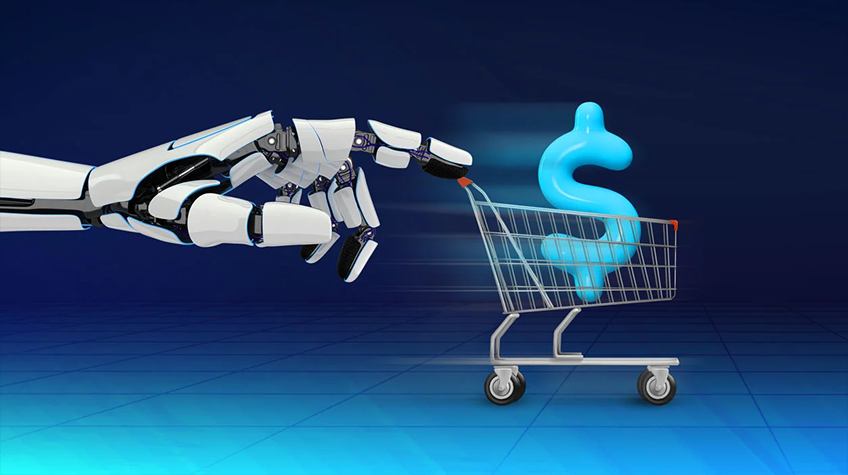
Artificial intelligence is reshaping e-commerce website development by providing better personalized experiences, improving customer support, and enhancing how things are done at the back end. Let’s examine how AI is changing things, the obstacles faced, and the best ways to succeed in e-commerce website development with AI.
AI is impacting the way e-commerce websites are being developed and how they run. AI is helping to improve how retailers handle customer needs and keep stock. Today’s e-commerce companies want websites that can respond to customer needs, provide instant help, and manage large amounts of data efficiently. AI offers much more than this. Developers use the power of AI to build intelligent interfaces for users, propose goods to them, and detect fraud in real time.
AI allows e-commerce sites to compete in a market that is always moving quickly. AI helps companies provide services and products that match rising consumer expectations with more accuracy and speed. This guide highlights the AI’s impact on e-commerce web development, the obstacles a company faces with the implementation of AI, and top tips for the successful use of AI.
How AI is Reshaping E-commerce Website Development?
1. Smarter Personalization

Artificial intelligence allows websites to customize the shopping experience for each user. The system uses search records, earlier purchases, and browsing history to suggest products that suit what the user likes. As an example, an AI engine can choose clothes for customers that are trending and fit with their usual style. Because shopping is personalized in real time, finding what you need becomes much simpler.
These systems on websites are built with the help of machine learning and user segmentation algorithms. So, every user gets a personalized website that catches their attention and is meaningful to them.
2. Enhanced Customer Support with AI Chatbots
Chatbots assisted by AI are now necessary for e-commerce businesses. These bots answer common concerns from customers about their packages, return policies, and available products. They are active all day and can control thousands of chats simultaneously. In contrast to traditional support, an AI chatbot keeps learning from each interaction. They use Natural Language Processing (NLP) to make bots understand and respond like humans.
Providing quick and correct information helps businesses achieve better results with satisfied customers. Chat support powered by artificial intelligence reduces the team required for customer support, saving time, money, and providing an easy experience for everyone.
3. AI for Inventory and Supply Chain Management

It makes managing inventory simpler for businesses, as it relies on past sales records, seasonal patterns, and current demand to predict stock levels. As a result, shops can prevent having too many or too few best-selling products. AI can improve the supply chain by projecting delays and recommending alternate ways or sources to use.
Developers bring AI into the backend to automate the addition of dashboards and alerts. As a result, the warehouse logistics remain intact, and the balance of inventory is always maintained. Shopping is made smoother, costs are lowered, and choices are made more reliably, all thanks to live data.
4. Improved Visual Search and Voice Search
Customers can now search for products easily by voice commands or simply by taking pictures with their phone. Users can take a photo with their phone and locate products that are similar. The software can identify the shape, color, and pattern of a sample by using image recognition.
Using Google Lens or Amazon Alexa is one way developers give e-commerce websites these capabilities. As a result, buying online is easier and possible for people using their phones. Powering search with AI takes the hassle out of search and makes the experience straightforward for users.
5. Fraud Detection and Cybersecurity
AI helps greatly in detecting and preventing fraud on the internet. It tracks how you use the site, make payments, and sign in to find any unusual activity. In case AI discovers suspicious behavior, such as someone trying to log in many times in a row or a sudden location shift, it can send warnings or halt any related transactions. With the help of machine learning, developers make systems that identify and handle new kinds of fraud.
AI is used to identify and fix any weaknesses in payment gateways and customer data as they are found. Using this method helps in keeping both online shoppers and companies safe while making transactions.
6. Dynamic Pricing Optimization
E-commerce websites use AI to immediately update their prices according to changes in the market, competitors, how users act, and their products in stock. Dynamic pricing helps businesses to stay on par with competitors and get the most profit. For instance, when a product is suddenly popular, the AI system will raise the price to meet the current demand.
Alternatively, some retailers may lower their prices when there isn’t much demand to make sales. AI algorithms are being developed by developers to watch both pricing trends and the feedback received from customers. Automated pricing can save a business time and guarantee the right price is set at the best moment.
Hurdles in Implementing AI for E-commerce Website Development

- High Cost of Implementation: Large costs for AI tools, infrastructure, and programmers mean that small and mid-sized businesses often do not consider AI.
- Lack of Quality Data: It is important for AI systems to receive accurate data that is well put together for them to work well. A number of businesses find it hard to handle or gather this type of data.
- Complex Integration: Integrating AI and legacy systems can be both tough and take a lot of time.
- Shortage of Skilled Talent: Developing and managing AI features is possible only after getting developers, data scientists, and machine learning experts on board, but these positions can be hard to recruit.
- Privacy and Compliance Issues: There are many privacy concerns to consider when working with user data using AI. Every business must obey GDPR and handle personal data ethically.
- Difficulty in Measuring ROI: Because personalization and automation driven by AI are not directly visible results, many companies find it difficult to accept the costs involved.
- Maintenance and Updates: AI tools require frequent monitoring, updating, and training to work well for a long time.
Best Practices for Implementing AI in E-commerce Website Development

1. Start with Clear Goals
First, find out the particular issues AI can help your e-commerce business with. To improve customer service, recommend what is most relevant or manage your inventory properly, specific objectives will show you how to do well and confirm your progress.
2. Run Small Pilot Projects First
First, focus on using AI in a test scenario instead of a complete implementation. As a result, you have time to check how it’s functioning, get feedback, and revise the features before connecting everything across the entire organization.
3. Use Clean and Relevant Data
AI depends on having top-quality data to work well. Ensure your client, product, and transaction information is categorized, full, and accurate. Higher-quality data brings a better understanding and is less likely to cause false predictions from artificial intelligence.
4. Hire or Partner with AI Experts
Team up with professionals who know how to use technology and what is needed for e-commerce. Because of their expertise, your AI software is both effective, safe and can be used on a large scale.
5. Prioritize Privacy and Compliance
Make sure to follow GDPR and CCPA when you are using your customers’ data. Always share how you use information collected by AI and guarantee your actions to respect the privacy and consent of each user.
6. Monitor and Optimize AI Performance
API systems need to be updated and tested on a regular basis. Watch the results, get user comments, and adjust the algorithms often to make sure they reflect new customer habits.
7. Focus on Enhancing User Experience
Always build AI tools with a focus on how easy they are for your customers to use. Artificial intelligence should make it simpler and more personal to shop, without creating any confusion or bothering people. AI tools that are simple, intuitive, and responsive offer greater benefits to users.
Conclusion
In conclusion, AI is changing how e-commerce websites are developed and managed. Efforts in personalizing, supporting, and detecting fraud can all be improved by AI. Still, for Artificial Intelligence to work well, we need a reliable strategy, expert staff, and an eye on using it responsibly. Knowing about the pros and cons helps companies use AI to provide smart, personalized, and efficient shopping experiences online. As technology improves, the future of e-commerce will depend on the current use of AI.






